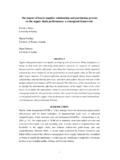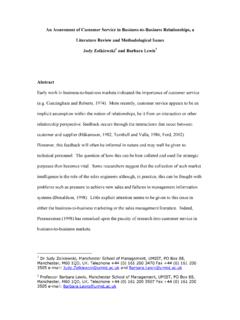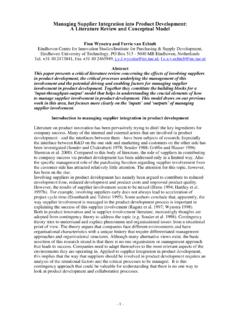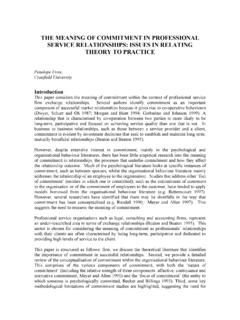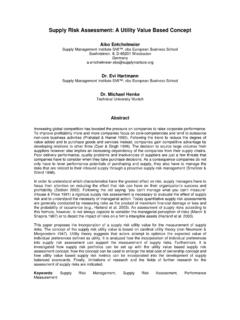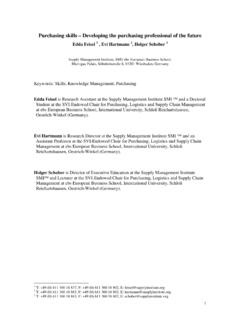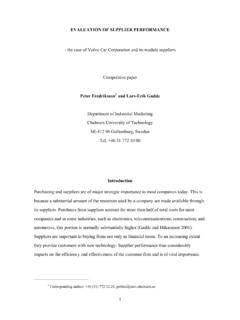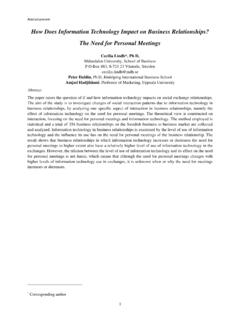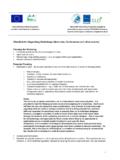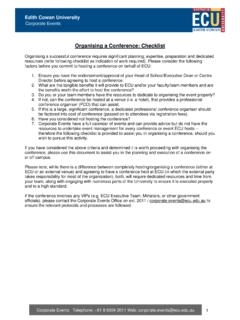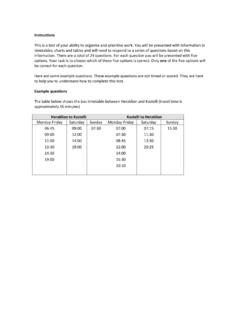Transcription of Organising the Purchasing Function as an Interface …
1 Organising the Purchasing Function as an Interface between internal and external Networks Anna Dubois Division of Industrial Marketing Chalmers University of Technology S-412 96 G teborg, Sweden Finn Wynstra RSM Erasmus University PO Box 1738 3000 DR Rotterdam, Netherlands Abstract During recent years, increasing specialisation and complex market structures have made companies divide their Purchasing functions into several organisational units to cope with increasingly diversified demands on linking the internal operations within the firm with operations at their suppliers.
2 In this paper, we focus on Organising of the Purchasing Function as an Interface between internal and external counterparts. We suggest a framework focusing on how the Purchasing Function works as an Interface between the firm s suppliers and (other) firm internal functions, such as production, product development and marketing. The framework builds on two dimensions; one that describes how the Purchasing Function of a firm relates to other internal functions and one describing how it relates to suppliers.
3 The Purchasing situations described by the framework are illustrated with some examples. Also, the ways in which the Organising principles can be aligned to Purchasing strategies are discussed. We conclude with some possible avenues for further research to explore the insights the framework may generate. Key words: Purchasing Function , organisational interfaces, Purchasing strategy 1 Introduction The Purchasing Function in most companies has become subject to changes in its internal as well as external relations in recent years.
4 Possibly as a result from this it seems as if the Purchasing Function in many firms has developed from one Purchasing department into a number of organisational units that are organised differently in relation to several other internal functions in order to cope with their different demands. The aim of this paper is to elaborate on the Organising of the Purchasing Function as an Interface between firm internal functions and external counterparts. The way in which the Purchasing Function is organised has been subject to research interest.
5 In particular, the issue of whether the Function should be centralised or decentralised has been studied. This issue is of considerable empirical relevance and many firms have been observed to change back and forth between the two over time. According to Gadde and H kansson (2001) the main internal reason for centralisation is that it promotes professionalism among buyers and that resources may be allocated efficiently. On the other hand, centralisation can make it difficult to integrate the Purchasing operations with those of other functions.
6 It is part of the total operations of the company, implying that integration with those other activities is a main concern. In the decentralized Purchasing organization buyers are located together with people from manufacturing and engineering rather than with other purchasers, simplifying inter-departemental interaction, but making Purchasing per se less professional. (Gadde and H kansson 2001: 108) Hence, a strong argument in favour of a decentralised approach to Organising the Purchasing Function is that it becomes increasingly important for firms to promote internal interaction with other functions.
7 Purchasing has become more complex owing to increasing specialisation and technical sophistication. Therefore, the development seem to be directed towards diversified Purchasing functions working closely with other units such as technical development, production, logistics functions etcetera. In the automotive industry, for instance, multi-functional teams including Purchasing representatives, has become a vital organisational principle for managing the development of modules (see von Corswant 2003). Apart from an increasing need for close interaction with product development functions, the Purchasing Function also has other tasks than to find and manage the co-operation with suppliers of vital components and modules.
8 For instance, designing and managing of the supply chain so that the flow of goods and information can be efficient, may require other internal and external relationships. Furthermore, Purchasing and management of MRO (Maintenance, Repair, Operations), Purchasing of production equipment, electricity etc. all require different internal interfaces between the Purchasing Function and other functions within the company. Not only the functions with which Purchasing needs to work display a variety, but also the nature of these relationships.
9 The ways in which the Purchasing Function of a company is organised also impacts heavily on how it may interact with external counterparts. Gadde and H kansson (2001) discuss two important aspects: (1) the benefits of supplier involvement in product development, and (2) how the choice between centralised and decentralised Purchasing impacts on external interaction. The need for early and close interaction with suppliers in development projects is again at the core of their argument. There is an abundance of literature addressing this issue (see Burt and Sukoup 1985; Takeuchi and Nonaka 1986; Clarke and Fujimoto 1991; Wynstra et al 2003) and more specifically on how modular technical designs can be used as a means to facilitate co-operation between buyers and suppliers in technical development (see Baldwin and Clarke 1997; Henderson and Clarke 1990; Kogut and Bowman 1995; Sanchez and Mahoney 1996; Sanchez 2000).
10 However, the Purchasing Function and how it is organised in relation to inter-organisational issues is not explicitly discussed. Inter-organisational issues have more often than not been separated from intra-organisational ones. When Purchasing is concerned, however, inter- and intra-organisational aspects may be seen as interdependent since how the firm works internally is closely related to how it relates to its environment and vice versa. Moreover, the effects of a certain way of working towards external counterparts may turn out differently depending on firm internal relations.
